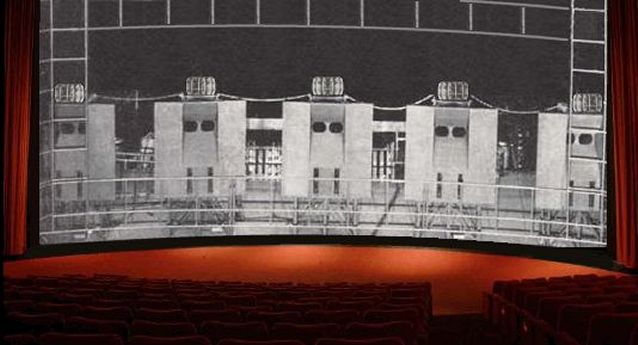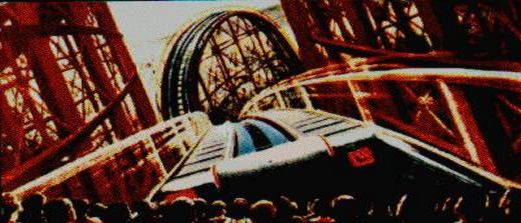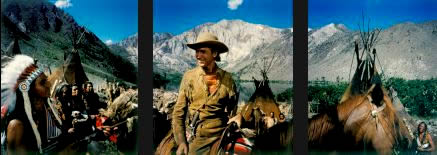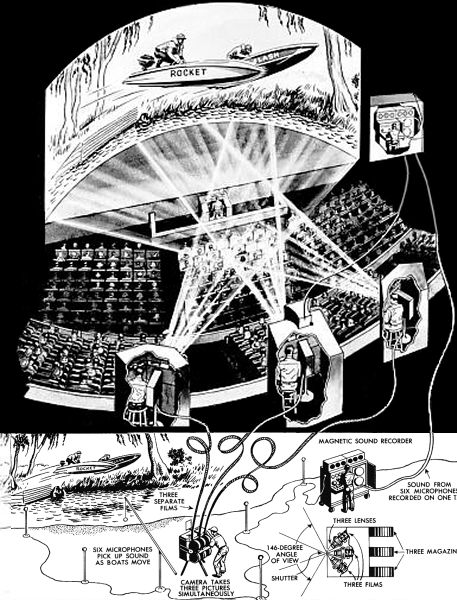During the 1950s and 60s special 70mm films were produced and shown in cinemas equipped with super wide curved screens often exceeding 50 feet. A single cinema was as large as today's multiplex, requiring to show the same film for many months or years to break even or make a profit.

Prior to digital recording the standard test for high quality analogue magnetic multi-track recorders was to repeatedly record and play back and record over and over until noticeable degradation appeared, which was approx 6 times. Only un-compressed digital recordings can achieve being repeatedly re-recorded with zero loss.
Many of the 70mm films had 6 independent channels of full fidelity magnetic sound tracks on the film stock. The sound fidelity was superior to most of the digital formats of today. The channel separation was so great that it was possible to independently record and play back different orchestral music on each track, with minimal loss or crosstalk. This separation enabled remarkable sound-scape that could emulate the experience of a real symphony orchestra on stage.

The cost of 70mm was more than 10 times greater compared to 35mm film. The process of applying the magnetic tracks to the 70mm film was extremely difficult, which was done at the end of the film stock's manufacturing process. The play back head on the projector had to be in perfect alignment, regularly inspected, meticulously cleaned and periodically de-magnetized and replaced when worn. This procedure was done with great pride and attention.
The only limitation was from partial de-magnetization of the sound tracks if the film stock was accidently placed against a transformer. But in all in all other respects the magnetic format was more robust and superior in performance to the optical format including today's digital.

Many of the large early cinemas equipped for showing 70mm cinemas in the 1950s were fitted with five speaker systems that were magnitudes greater in size than the majority of sound systems in cinemas today. (left) - (left-center)- (center) - (right-center) - (right) The five screen speaker systems were able to give precise sound positioning and even spatial movement across the screen. The single surround channel could be automated to left side - right side - rear - and overhead to simulate an aircraft flying around the room. However switching the surround channel was more commonly done with Cinerama.

Stanley Kubrick's '2001 A Space Odyssey' had its world premiere on 2 April 1968 and became the most successful film in this format. But many people were unable to experience it as he intended, as most of the large wide screen cinemas with 70mm projectors were closing to make way for the 'economically rational' new multiplexes equipped with the new improved 35mm projectors with improved Lens (Anamorphic) that could also achieve wide screen formats. Sound fidelity was no longer considered important as the economical rationalist belief was that the majority of the new emerging consumer driven generation have become obsessed with image and brand identification.
There are only a limited number of 70mm films being produced today (IMAX is 70mm) and sound reproduction is now rationalised to the modern digital format and uses the external DTS system. Today's compressed digital formats printed on 35mm film stock are far more restricted in fidelity with limited channel separation in comparison to the 6 analogue magnetic tracks on the earlier 70mm film.
During the early 60s I was apprenticed to an ex senior engineer of Western Electric UK who had been involved in pioneering technology for magnetic multiple track recording and large scale sound systems for cinema and auditoriums. He and his fellow engineers had been with the cinema industry from the beginning of sound. In the 1950s they believed that the full fidelity magnetic format was the way of the future, and the optical low fidelity format would go the way of the Dodo, especially since Television had arrived. I think back in regret at how I could have paid more attention to all they tried to teach me. But as a 17yr old in the early 60s my primary interests were creating sound systems and mixing for hi-energy blues bands, surfing and chasing free love, which I never caught.


Cinerama was without doubt the greatest achievement in cinematic history. Created by people of genius, madness and unlimited passion. Russia also had its own equivalent Kino-panorama. This is what going to the movies is about, 'To be beamed up and blown away'. The opening roller coaster ride caused everyone to tightly grip their seats and hang on for their lives, screaming with excitement. Paper bags were also supplied for emergencies. I was 12 in 1957 when I first experienced Cinerama.
Cinerama consisted of three projectors covering a giant 146deg super wide curved screen that included peripheral vision, enabling a 3D experience to be achieved. Cinerama was spoken of as an experience separately from just being seen. The only limitation was the annoying joining lines which were eventually minimised.


The sound was supplied from a separate 35mm 7 track magnetic tape machine that sync locked the 3 projectors. There were 5 giant speaker systems behind the screen as well as surround speakers, as shown in the below pic. After intermission there was a demonstration of the sound system effortlessly replicating a symphony orchestra as though it was actually present on stage. It was this effect of hearing an accurate replication of sound reality and detailed positioning of a symphony orchestra that resulted in electro-acoustic technology becoming the passion of my lifes' work.




